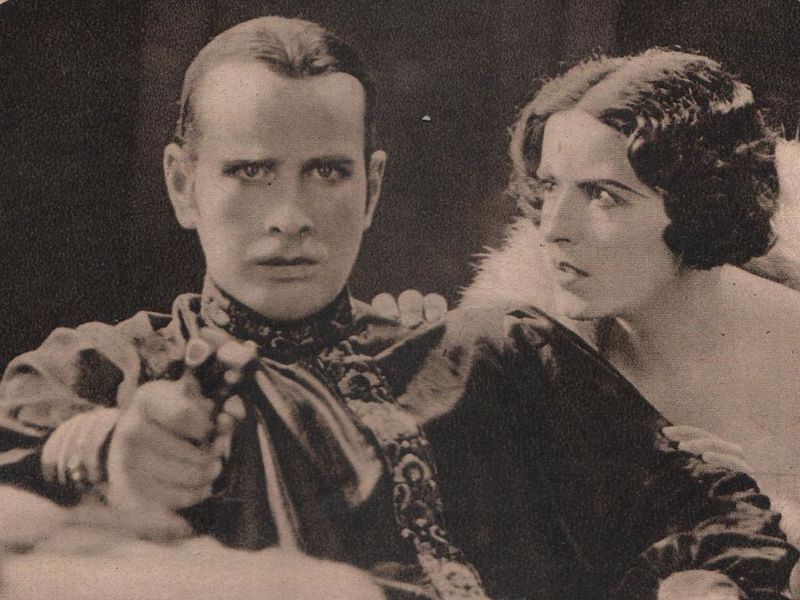DAS LETZTE SOUPER (Théâtre)
(The Last Performance)
Mario Bonnard (DE 1928)
Mario Bonnard’s extended German sojourn began in 1926, three years after Marcella Albani (1899-1959) made her way north to join the exodus of fellow Italians looking for more fertile cinema prospects. Director and star made four films together, two of which are in this year’s program. While Das letzte Souper doesn’t have the same degree of outlandishness as Bonnard’s Der goldene Abgrund, screened in 2018, it’s an engrossing backstage tale, which starts with a tangle of jealousies and ends with a murder investigation. It’s also a higher-end production, backed by Seymour Nebenzahl’s prestigious Nero-Film and shot by Günter Krampf, better known for Orlacs Hände (1924) and Die Büchse der Pandora (1929), among other notable titles.
The impressive cast is headed by the great Heinrich George as Boris Stroganoff, an opera composer and conductor who’s also a notorious lothario. Albani is ballet dancer Viola Suroff, who’s put her career aside to look after her partner Maxim Sadi, a baritone with unspecified health issues that have kept him off stage. Stroganoff sets his sights on Viola and offers her a job in the corps de ballet for his new opera The Boyar, which she accepts provided Maxim is also hired. However, dancer Margot (called Myrra in the French version) maintains a seething passion for Stroganoff, as does Countess Geschow (called Countess Ziska on this print), both of whom are resentful when watching his interactions with Viola. Jealousies run high on opening night between all the characters and Stroganoff is shot mid-performance, but who is the killer: Maxim, Margot, or Geschow?
Bonnard maintains a gratifying level of suspense through several striking montage sequences, from a classic rapid edit between backstage gossips to rhythmic cuts during the performance, resulting in a highly tense spectacle. The critic from Cine sorriso illustrato (06.10.1929) pointed out a certain banality in the storyline, but was full of praise for the way the director handled the scenes: “A frivolous subject which, when treated by Bonnard, manages to become very interesting. Bonnard achieves this through highly expressive and dynamic scenes (such as that of Boris’ murder and those that follow), crafted with the technique of a true master.”
Britain’s The Bioscope (26.12.1928) also commented on the mise-en-scène, singling out the “up-to-date camera effects, suggesting mental impressions.”
Albani’s love interest is played by Jean Bradin (1899-1969), known for E.A. Dupont’s Moulin Rouge and Alfred Hitchcock’s Champagne; the two were engaged to be married shortly after making the film but broke off the relationship several months later. Worth mentioning among the more minor characters is the always welcome presence of Siegfried Arno, in the comic role of Maxim’s friend, and Ita Rina (also seen at this year’s Giornate in the Estonian-German co-production Kire Lained), glimpsed towards the film’s end as the dancer who discovers the gun used to kill Stroganoff.
Jay Weissberg


regia/dir: Mario Bonnard.
scen: Curt J. Braun, dal racconto di/based on a short story by Otto Rung (“Kapelmesteren”(?), publ. pre-1910).
adapt FR: J. Faivre.
photog: Günter Krampf.
scg/des: Julius von Borsody.
prod mgr: Arthur Bredow.
cast: Marcella Albani (Viola Suroff), Heinrich George (Boris Stroganoff), Jean Bradin (Maxim Sadi [Maxime Sadi]), Evi Eva (Margot [Myrra]), Siegfried Arno (Gaston [Freddy]), Ita Rina (Maria), Wolfgang von Schwindt (Dombrowsky), Corry Bell (Elsa), Valerie Boothby (contessa/Countess Geschow [Ziska]), Paul Hörbiger (maestro di ballo/ballet master), Raimondo Van Riel (Zemikoff), Otto Kronburger (commissario di polizia/police commissioner), Otto Wallburg (Tenas), Eduardo d’Accurso (Paschkin).
prod: Seymour Nebenzahl, Nero-Film; Jakob Karol-Film.
dist: Bayerische Film.
v.c./censor date: 08.10.1928.
uscita/rel: 05.11.1928.
copia/copy: 35mm, 1717 m. (orig. 2036 m.), 68′ (22 fps); did./titles: FRA.
fonte/source: Cinémathèque Royale de Belgique, Bruxelles.




